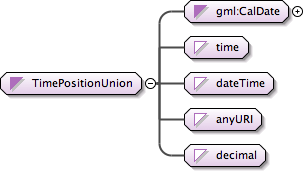| Namespace | http://www.opengis.net/gml | ||
|
Annotations
|
The ISO 19108:2002 hierarchy of subtypes for temporal position are collapsed
by defining a union of XML Schema simple types for indicating temporal position relative
to a specific reference system.
Dates and dateTime may be indicated with varying degrees of precision.
dateTime by itself does not allow right-truncation, except for fractions of seconds.
When used with non-Gregorian calendars based on years, months, days,
the same lexical representation should still be used, with leading zeros added if the
year value would otherwise have fewer than four digits.
An ordinal position may be referenced via URI identifying the definition of an ordinal era.
A time coordinate value is indicated as a decimal (e.g. UNIX time, GPS calendar).
|
||
|
Diagram
|
 |
||
| Type | union of(gml:CalDate, time, dateTime, anyURI, decimal) | ||
|
Used by
|
|
||
|
Source
|
|
||
| Schema location | http://schemas.opengis.net/gml/3.1.1/base/temporal.xsd |